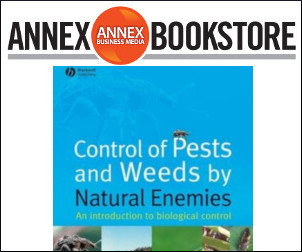| |
| |
 |
 |
| |
 |
|
July 23, 2019 |
|
| |
The European corn borer (ECB) is a boring little brown moth, notes OMAFRA greenhouse vegetable specialist Cara McCreary, but their larvae are anything but.
» Read more...
Poinsettia don’t have many problems, note OMAFRA floriculture specialists Dr. Sarah Jandricic and Dr. Chevonne Dayboll, but when issues arise, they can hit a crop fast and hard.
» Read more...
Succession planning is much more than just having a will. It extends to business structuring to make transitions legally smooth and tax efficient.
» Read more...
|
| |
|
| |

Biological control – utilizing a population of natural enemies to seasonally or permanently suppress pests – is not a new concept. The cottony cushion scale, which nearly destroyed the citrus industry of California, was controlled by an introduced predatory insect in the 1880s. Accelerated invasions by insects and spread of weedy non-native plants in the last century have increased the need for the use of biological control. Use of carefully chosen natural enemies has become a major tool for the protection of natural ecosystems, biodiversity and agricultural and urban environments.
>> Order now! |
| |
|
| |
 Researchers have developed a more sustainable method to keep crops safe from pests. Typically, producers invest a significant amount of their crop production costs towards purchasing and applying biological control agents to fight pests. Once they do their jobs, however, control agents tend to disappear from crops because their food source (the pest) is gone.
» Learn more
Researchers have developed a more sustainable method to keep crops safe from pests. Typically, producers invest a significant amount of their crop production costs towards purchasing and applying biological control agents to fight pests. Once they do their jobs, however, control agents tend to disappear from crops because their food source (the pest) is gone.
» Learn more |
| |
 While sulphur is applied at the lowest concentration of all the macronutrients in fertilizer solutions, it is typically applied in excess of the plant’s needs. Recently, University of Guelph researchers tested methods for reducing sulphur supplied to sub-irrigated, potted, disbudded chrysanthemums, decreasing sulphur delivery by over 87 per cent.
» Learn more
While sulphur is applied at the lowest concentration of all the macronutrients in fertilizer solutions, it is typically applied in excess of the plant’s needs. Recently, University of Guelph researchers tested methods for reducing sulphur supplied to sub-irrigated, potted, disbudded chrysanthemums, decreasing sulphur delivery by over 87 per cent.
» Learn more |
| |
|
| |
|
|
| |
| |





